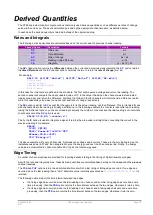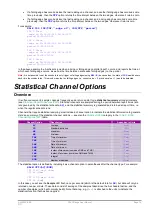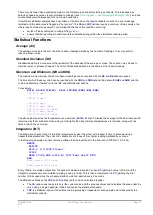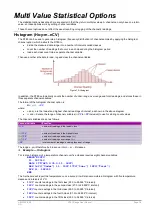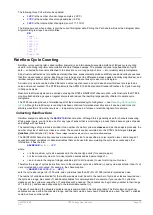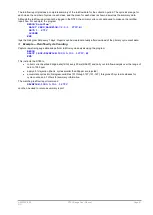
UM-0085-B09
DT80 Range User Manual
Page 66
RG
Note1:
in this case the default signal coordinates (0 and 100) are used, because the L (current loop) channel type returns a value in the
range 0-100%.
Once defined, a span may be applied to any number of channels in any schedules or alarms using the Sn channel
option.
In the following example, two of the above current loop pressure sensors are used, plus a frequency input which passes
through a 10:1 prescaler (frequency divider):
BEGIN"MONKEY"
S1=0,10,0,1"Hz" ' multiply measured freq by 10
S2=0,300"kPa" ' scale 0-100% to 0-300kPa
RA10S 1#L(S2,"Inlet") 2#L(S2,"Outlet") 4F(S1)
END
This will return data in the form:
Inlet 23.9 kPa
Outlet 119.0 kPa
4F 3920 Hz
Note2:
for the F channel type the channel factor indicates the sample period, so it cannot be used as a scaling factor. A span is
therefore used instead.
A span can also be applied in reverse, using the
SR
n
channel option. Thus
S1=0,100,32,212 1CV(S1)
is equivalent to
S1=32,212,0,100 1CV(SR1)
Polynomials (Yn)
Polynomials are used to define calibrations for non-linear sensors. Each defined polynomial can have up to six
polynomial coefficients.
The DT80 evaluates a polynomial according to the formula
𝑦
0
=
𝑘
0
+
𝑘
1
𝑥
+
𝑘
2
𝑥
2
+
𝑘
3
𝑥
3
+
𝑘
4
𝑥
4
+
𝑘
5
𝑥
5
where x is the raw channel reading, and the k’s are coefficient terms.
A polynomial is defined in a similar way to a span:
Y
n
=
k0
,
k1
,
k2
,
k3
,
k4
,
k5
"
units
"
where:
•
n
is the
poly/ span number
(1 to 50), which is used simply to distinguish one polynomial from another. Note
that a span and a polynomial cannot have the same number.
•
k0 … k5
are the polynomial coefficients. If not specified, a coefficient value of zero is assumed
•
units
replaces the channel's default units text
The required coefficients may be supplied by the sensor manufacturer, or they may be determined from a calibration
curve or from measured data points using a least squares regression technique. Various statistical programs are
available for this purpose.
Once defined, a polynomial may be applied to any number of channels using the Yn channel option. For example:
Y1=23.5,0,0.987"deg C"
RA1M 1V(Y1) 2V(Y1)
Thermistor Scaling (Tn)
The DT80 has channel types (e.g. YS03) for many 2-wire thermistors manufactured by MEAS (formerly Yellow Springs
Instruments). For other thermistor types, the DT80 supports thermistor scaling — the conversion of a resistance reading
to a temperature. The DT80 does the conversion from resistance to temperature using
𝑇
=
1
𝑎
+
𝑏
(ln
𝑅
) +
𝑐
(ln
𝑅
)
3
To apply thermistor scaling, firstly obtain the constant terms a, b and c from the thermistor manufacturer, then define a
thermistor conversion in a similar way to a polynomial or span:
T
n
=
a
,
b
,
c
"
units
"
where:
•
T
is the temperature, in Kelvin (K)
•
n
is the
thermistor conversion number
(1 to 20), which is used simply to distinguish one thermistor equation
from another.
























